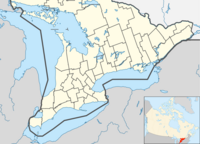Ballinafad, Ontario
| Erin | ||
|---|---|---|
| Town (lower-tier) | ||
| Town of Erin | ||
|
||
 Location of Erin within Wellington County |
||
| Location of Erin within southern Ontario | ||
| Coordinates: 43°46′N 80°04′W / 43.767°N 80.067°WCoordinates: 43°46′N 80°04′W / 43.767°N 80.067°W | ||
| Country |
|
|
| Province |
|
|
| County | Wellington | |
| Established | 1820 | |
| Amalgamated | 1997 | |
| Government | ||
| • Mayor | Allan Alls | |
| • Governing Body | Town of Erin Council | |
| • MP | Mike Chong (Con) | |
| • MPP | Ted Arnott (PC) | |
| Area | ||
| • Town (lower-tier) | 297.75 km2 (114.96 sq mi) | |
| • Urban | 4.77 km2 (1.84 sq mi) | |
| Population (2011) | ||
| • Town (lower-tier) | 10,770 | |
| • Density | 36.2/km2 (94/sq mi) | |
| • Urban | 2,674 | |
| • Urban density | 560.6/km2 (1,452/sq mi) | |
| Time zone | EST (UTC-5) | |
| • Summer (DST) | EDT (UTC-4) | |
| Postal Code FSA | N0B | |
| Area code(s) | 519 | |
| Website | www.erin.ca | |
Erin is a town in Wellington County, approximately 80 kilometres (50 mi) northwest of Toronto, Ontario, Canada. Erin is an amalgamated town, composed of the former Villages of Erin and Hillsburgh, and the hamlets of Ballinafad, Brisbane, Cedar Valley, Crewson's Corners, Ospringe, and Orton, as well as the former Township of Erin. Erin's Town Council includes a Mayor (Allan Alls, 2014-2018) and four councillors. Its upper tier government is provided by Wellington County.
Erin is primarily a rural community but, while farming is still an important activity in the town, most of its population works in the nearby cities of Brampton, Mississauga, Guelph, and even Toronto. The town's new industrial park is attracting a number of new industries, due to its cheaper tax rate, accessibility to transportation, and its location within the "Technology Triangle," a series of high-tech driven cities including nearby Kitchener. Waterloo, and Cambridge.
The community not for profit organization is East Wellington Community Services.
A settlement developed after mills were built on the Credit River between 1826 and 1829. The first settlers included Daniel MacMillan and the Trout family. The settlement was established as "MccMillan's Mills" although most sources indicate that the Trout family built the first sawmill. Even so, Daniel MacMillan and his brothers are acknowledged as significant contributors to the growth of the village.
By 1839 a post-office had opened. Records from 1841 indicate that the entire Township of Erin had a population of just 1,368. By 1846, the small settlement in the south-west of the township, then called McMullen's Mills, had a grist and saw mill, a tavern and blacksmith's shop but only 40 to 50 residents.
In 1849, the first place of worship, the Union Church was being used by several denominations. Previously, services had been held in homes and in other available buildings. By 1851, the population increased to 300; the name of the settlement was Erinsville at the time but was later shortened to Erin. Businesses in the area included a distillery, a tannery, and carding, oatmeal and grist-mills. The river provided the power for mills, helping to boost agriculture, milling and wood products manufacturing. By 1869 the population was 600 and the post office was receiving mail daily.
...
Wikipedia


